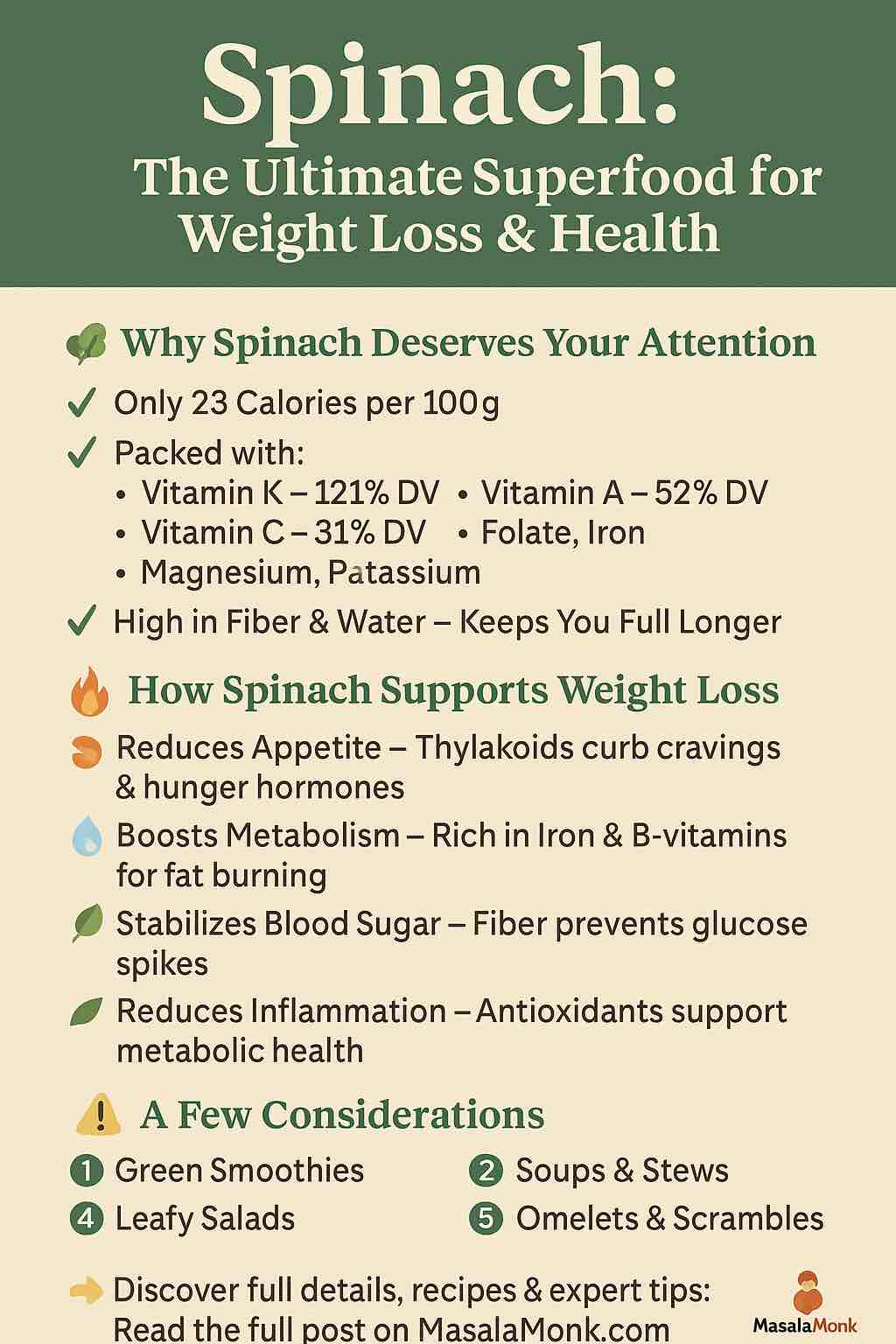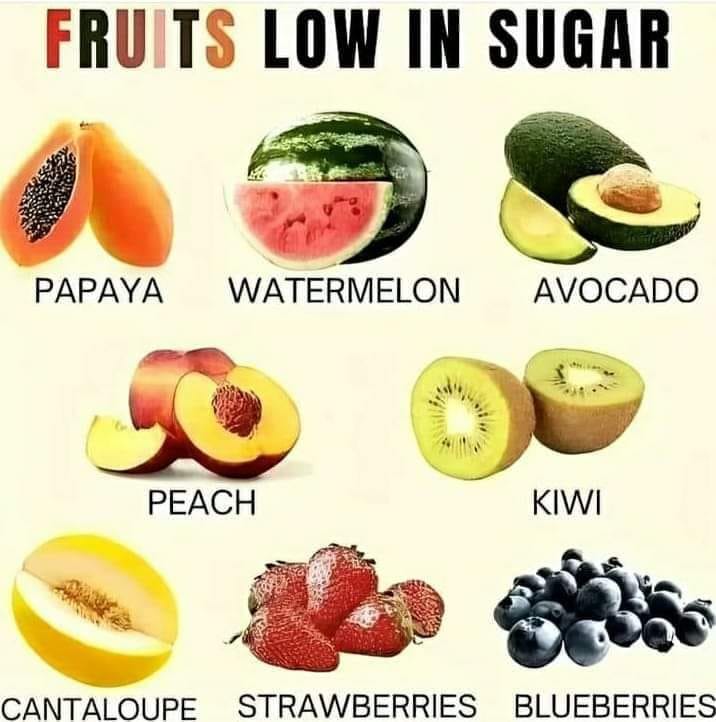
“In a world full of processed, calorie-dense foods, spinach remains nature’s simple yet powerful solution to health and weight management.”
Introduction: Why Spinach Deserves the Spotlight
In the vast world of superfoods, spinach often gets overshadowed by trendy new arrivals — but this humble leafy green remains one of the most nutrient-packed, calorie-efficient, and versatile foods available. Whether you’re looking to shed a few pounds, enhance your energy levels, or simply nourish your body with clean, dense nutrition, spinach checks all the boxes.
Backed by both ancient wisdom and modern scientific research, spinach delivers a remarkable combination of vitamins, minerals, antioxidants, and unique plant compounds that offer profound health benefits — particularly for those aiming to lose weight without compromising nutrition.
In this comprehensive guide, we’ll explore:
- Spinach’s detailed nutritional profile
- How it specifically supports weight loss
- Its wide-ranging health benefits
- Important cautions and considerations
- 5 practical, easy ways to incorporate spinach into your daily routine
1️⃣ Spinach Nutrition Breakdown: Small Calories, Huge Nutrients
Let’s start by looking at exactly why spinach is often called a “nutrient powerhouse.” Here’s what 100 grams (roughly 3.5 ounces) of raw spinach provides:
| Nutrient | Amount | % Daily Value (DV) |
|---|---|---|
| Calories | 23 kcal | – |
| Water | ~91% | – |
| Protein | 2.9 g | – |
| Carbohydrates | 3.6 g | – |
| Fiber | 2.2 g | – |
| Sugars | 0.4 g | – |
| Vitamin K | 483 mcg | 121% |
| Vitamin A | 469 mcg | 52% |
| Vitamin C | 28 mg | 31% |
| Folate (B9) | 194 mcg | 49% |
| Iron | 2.7 mg | 15% |
| Magnesium | 79 mg | 20% |
| Calcium | 99 mg | 10% |
| Potassium | 558 mg | 12% |
| Vitamin E | 2 mg | 13% |
✅ Key Takeaway:
Spinach delivers an extraordinary amount of essential nutrients with negligible calories. This makes it one of the most nutrient-dense foods on the planet.
2️⃣ How Spinach Aids Weight Loss
Spinach isn’t a magical weight-loss solution by itself — but science shows that it creates the perfect environment for sustainable fat loss. Here’s why:
a) Low in Calories, High in Volume
Spinach contains only 23 calories per 100 grams, but thanks to its high fiber and water content, it adds significant bulk to meals. This allows you to eat larger portions and feel full while consuming fewer calories.
b) Rich in Fiber: Natural Appetite Control
The 2.2 grams of fiber per 100 grams of spinach slow digestion, stabilize blood sugar, and keep you feeling fuller longer. Fiber reduces the likelihood of binge-eating or unhealthy snacking between meals.
c) Thylakoids: Spinach’s Hidden Weapon
Recent research highlights that spinach contains thylakoids — microscopic structures found in plant cells that may play a major role in appetite suppression.
- Thylakoids stimulate satiety hormones like GLP-1 and CCK.
- They help reduce cravings for sweet and fatty foods.
- Clinical studies have shown that consuming spinach extracts rich in thylakoids can reduce hunger and lower caloric intake over time.
d) Supports Metabolism
Spinach is rich in iron, magnesium, and B vitamins — all critical for energy production and metabolic efficiency. When your metabolism is running optimally, your body burns calories more effectively.
e) Balances Blood Sugar
Thanks to its fiber and antioxidant content, spinach helps maintain steady blood sugar levels — a crucial factor for anyone trying to manage hunger and avoid insulin spikes that can lead to fat storage.
f) Reduces Inflammation
Obesity and weight gain are often linked to chronic inflammation. Spinach’s antioxidants (like quercetin, lutein, and zeaxanthin) actively reduce inflammation markers, supporting overall metabolic health.
📌 Summary:
Spinach helps reduce calorie intake, promotes satiety, balances hormones, and supports metabolic health — all of which create the perfect conditions for sustained weight loss.
3️⃣ Spinach’s Broader Health Benefits
Beyond weight loss, spinach offers numerous other advantages for overall health:
✅ Cardiovascular Protection
- High nitrate content supports healthy blood pressure by increasing nitric oxide, which relaxes blood vessels.
- Antioxidants help prevent arterial plaque buildup.
- Folate contributes to lower homocysteine levels, a heart risk marker.
✅ Bone Strength
- Spinach is one of the best sources of vitamin K, which is essential for bone mineralization.
- Magnesium, calcium, and vitamin C also support skeletal health.
✅ Eye Health
- Rich in lutein and zeaxanthin — carotenoids that protect the retina and prevent macular degeneration and cataracts.
✅ Skin, Hair, and Nail Health
- Vitamins A, C, and E promote collagen synthesis, reduce oxidative stress, and support healthy hair and skin.
- Iron supports oxygenation of hair follicles, preventing hair thinning.
✅ Cognitive and Mental Well-being
- Antioxidants may reduce age-related cognitive decline.
- Magnesium plays a role in mood regulation, stress reduction, and sleep quality.
✅ Immune System Support
- Vitamin C, beta-carotene, and other micronutrients enhance immune defense.
4️⃣ Cautions and Considerations
While spinach is extremely healthy, certain groups should exercise caution:
➔ Oxalate Content
- Spinach is high in oxalates, which can contribute to kidney stone formation in susceptible individuals.
- Cooking (especially boiling and discarding water) reduces oxalate levels significantly.
➔ Vitamin K Interference
- Those on blood thinners (e.g., warfarin) should maintain a consistent spinach intake and consult with their physician to avoid affecting medication efficacy.
➔ Digestive Issues
- Its high fiber content may cause bloating or discomfort in individuals with sensitive digestive systems. Start with small amounts and gradually increase intake.
➔ Purines and Gout
- Spinach contains purines, but current research shows it has a minimal effect on gout risk compared to animal-based purine sources.
5️⃣ 5 Practical Ways to Add Spinach to Your Weight Loss Diet
One of spinach’s biggest advantages is its flexibility in cooking. Here are 5 simple, delicious ways to include it daily:
1️⃣ Leafy Green Salads
- Base your salads with fresh baby spinach leaves.
- Add lean proteins (grilled chicken, tuna, tofu).
- Include healthy fats (olive oil, avocado).
- Top with seeds or nuts for added crunch.
2️⃣ Smoothies
- Blend spinach with bananas, berries, Greek yogurt, and almond milk.
- Its mild flavor blends well without overpowering the taste.
- A nutrient-packed breakfast or post-workout snack.
3️⃣ Soups & Stews
- Toss fresh or frozen spinach into soups and stews during the last few minutes of cooking.
- This enriches both the nutrition and the texture of the dish.
4️⃣ Omelets & Scrambles
- Add a generous handful of spinach to scrambled eggs or omelets.
- Combines high-quality protein with the benefits of spinach’s fiber and micronutrients.
5️⃣ Pasta & Stir-Fries
- Mix sautéed spinach into whole-grain pasta or stir-fries.
- Pair with lean protein sources like shrimp, chicken, or tempeh for a balanced meal.
Conclusion: Small Leaf, Big Impact
Spinach isn’t flashy. It’s not exotic. But it’s highly effective.
Incorporating spinach into your daily routine offers you a simple, affordable, and research-backed way to:
- Cut calories without cutting nutrients.
- Support weight loss while improving overall health.
- Add versatility and color to almost any meal.
If you’re serious about your weight loss or health journey, let spinach be one of your daily green allies. Small habits — like adding spinach — create lasting change.
Bonus Tip 🌿
Frozen spinach retains almost all of its nutrients, is budget-friendly, and makes year-round consumption easier than ever. Don’t hesitate to keep a stash in your freezer!
📌 10 Frequently Asked Questions (FAQs)
1️⃣ Is spinach good for weight loss?
Yes. Spinach is very low in calories while being high in fiber, water, and essential nutrients. Its fiber and thylakoid content help control hunger and cravings, making it an excellent food to include in weight loss diets.
2️⃣ How much spinach should I eat daily for weight loss?
There’s no strict rule, but 1–2 cups of fresh spinach daily is a safe and effective amount for most people. If using cooked spinach, ½–1 cup is sufficient, since cooking reduces its volume significantly.
3️⃣ Can I eat spinach every day?
Yes, for most people. Daily spinach consumption is generally safe and beneficial. However, individuals prone to kidney stones, or those on blood-thinning medication, should monitor intake and consult with a healthcare provider.
4️⃣ Does cooking spinach reduce its nutritional value?
Cooking spinach reduces certain water-soluble nutrients like vitamin C and folate, but increases absorption of others such as iron, calcium, and carotenoids. Both raw and cooked spinach have unique nutritional advantages.
5️⃣ Is frozen spinach as healthy as fresh spinach?
Yes. Frozen spinach retains most of its nutrients and is an excellent, convenient, and budget-friendly alternative. It’s especially useful for soups, stews, and cooked dishes.
6️⃣ Does spinach help with belly fat specifically?
While no food directly targets belly fat, spinach supports overall weight loss through appetite control, better metabolism, and improved blood sugar management — all of which indirectly help reduce abdominal fat over time.
7️⃣ Are there any side effects of eating too much spinach?
Excessive spinach intake may contribute to:
- Kidney stone risk (due to oxalates)
- Gastrointestinal discomfort (bloating, gas)
- Vitamin K interference (for those on blood thinners)
Moderation is key, and cooking spinach can help minimize oxalate levels.
8️⃣ Is spinach suitable for people with diabetes?
Absolutely. Spinach’s fiber content helps stabilize blood sugar levels, while its low glycemic load makes it a safe choice for diabetics. Always discuss any dietary changes with your healthcare provider.
9️⃣ Can spinach improve skin and hair health?
Yes. Spinach provides vitamins A, C, and E — crucial for collagen production, skin repair, and scalp health. Iron in spinach also supports healthy blood flow to hair follicles, potentially improving hair growth.
🔟 What is the best time to eat spinach for weight loss?
There’s no “best” time — spinach can be beneficial at any meal. Many prefer it in:
- Breakfast smoothies (for appetite control)
- Lunch salads (to stay full longer)
- Evening stir-fries or soups (light, nutrient-rich dinner)













